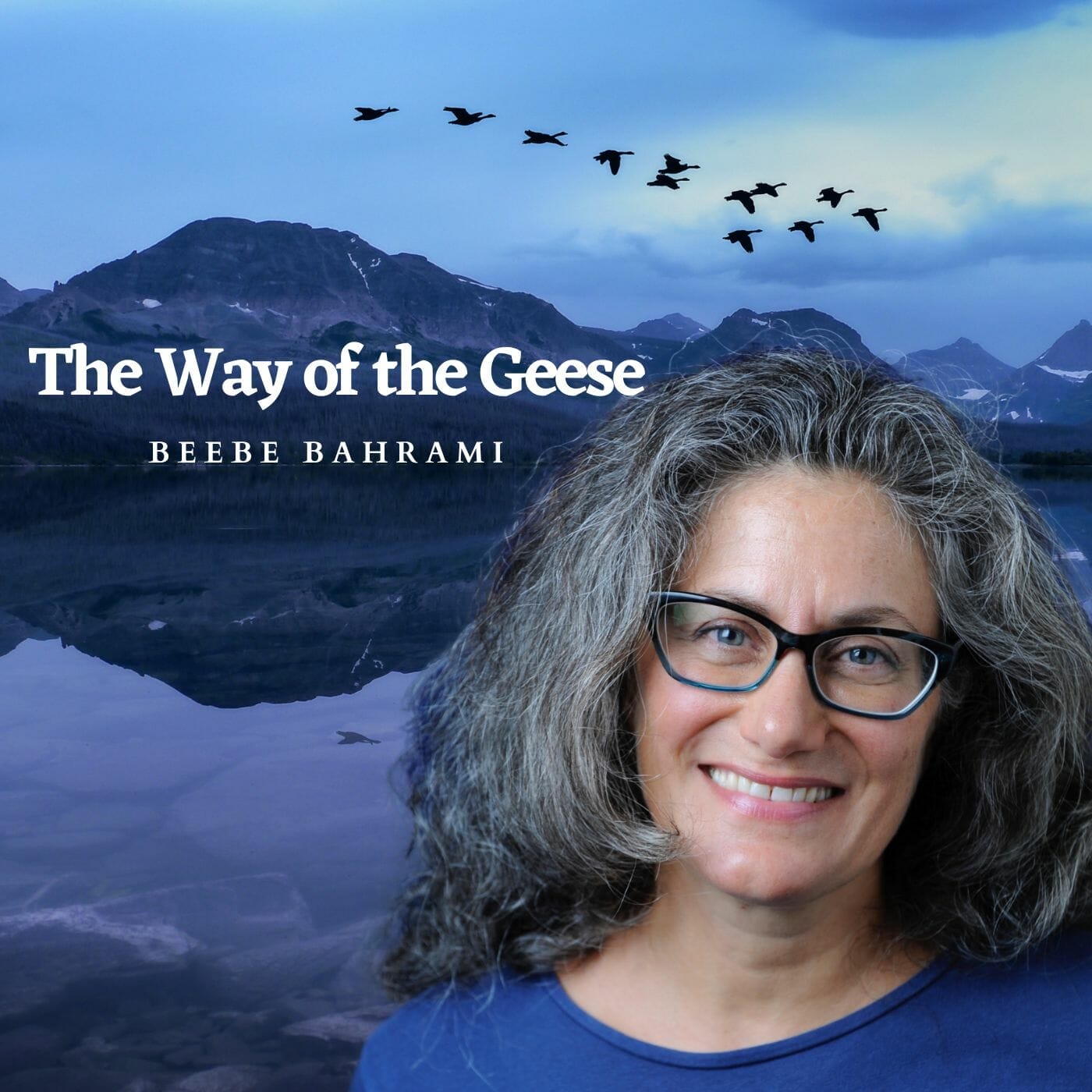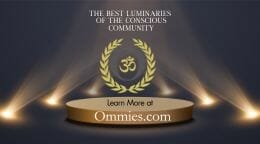Beebe Bahrami and The Way of the Wild Goose

Beebe Bahrami is an award-winning writer and anthropologist who specializes in the intersecting worlds of European, Atlantic, and Mediterranean cultures, from prehistory to the present, especially in France, Spain, and Portugal. Her latest book is The Way of the Wild Goose.
An Interview with Beebe Bahrami – The Way of the Wild Goose
Interview By Sandie Sedgbeer
To listen to the full interview of Beebe Bahrmi by Sandie Sedgbeer on the OMTimes Radio and TV show, What Is Going OM, click one of the players below.
Sandie Sedgbeer: From the 12th Century, Pilgrims have been walking the Camino, a network of roots traversing France, Spain, and Portugal that lead to the shrine of the Apostle St. James the Great, in the Cathedral of Santiago De Compostela in Galicia, in Northwestern Spain. In recent years, interest in this past has surged to the point where more than 200,000 people worldwide undertake some or all of this 500-mile journey every year. Over the past decade, I’ve interviewed several travelers who’ve made movies or written travel guides and memoirs about the Camino. And during that time, not in any of their narratives has anyone breathed a word about the ancient mysteries of web-footed Virgin Marys, mothers, goddesses, Templar Knights, fairytales, and geese that fill the pages of the Book, the Way of the Wild Goose. Three pilgrimages follow geese, stars, and hunches on the Camino De Santiago. I have with me today the award-winning travel writer, anthropologist, essayist, and author Beebe Bahrami. Welcome!
Beebe Bahrami: Thank you, Sandy.
Sandie Sedgbeer: So you are known for your travel narratives, your guidebooks, and your memoirs, which include Café Oc: A Nomad’s Tales of Magic, Mystery, and Finding Home in the Dordogne, Café Neandertal: Excavating Our Past in One of Europe’s Most Ancient Places, The Spiritual Traveler, Spain, Moon Camino de Santiago: Sacred Sites, Historic Villages, Local Food & Wine, and of course, the Way of the Wild Goose. So tell us, what first attracted you to the Camino?
 
Beebe Bahrami: Oh, I was a college student in exchange student in the south of Spain in 1986, and I was in a history of Spain course, and my professor uttered those three words, Camino de Santiago, and I didn’t even know yet what they were, he hadn’t started lecturing about them, but they just wedged their way into my cell tissue. And I thought, whatever that is, I must find out more about it. And then, when I learned that it was this historic medieval pilgrimage route across not just northern Spain but all of Spain, Portugal, France, and Webs across Europe, I fell in love with this idea, this high adventure of becoming a pilgrim on the road to Santiago. And it took nine years, but I finally got there and never stopped returning. So it’s a magical journey.
Sandie Sedgbeer: You said you stepped onto the Camino in 1995, but right from that moment, you felt that you had found your place in the world. I mean, what was that feeling like?
Beebe Bahrami: A very visceral feeling of belonging? You know, everything felt right. I felt like it was my own native ground that I was walking on and passing through. So the experiences just opened me up to many more layers in the world and possibilities, but also inside myself.
Sandie Sedgbeer: Did you feel that you knew this place, this land?
Beebe Bahrami: Yes. And going back to 1986, you know, I finished that semester nine years before I even got to walk the Camino de Santiago. I was journeying up to Paris to visit cousins, and just on the train as we were traversing those northern lands of Spain going through Nevada and Bass country and then into Accutane in southwestern France, I felt this uncanny, energetic pull; and it was an overnight train, and I couldn’t sleep. So I just stood at the window and gazed out the window and vowed that I would go back. And I did. It took a while, but I did, and that feeling was still there. It’s like nothing I’ve ever felt before, and it doesn’t go away. I was told that if you accept this invitation, there will be much to learn. And it’s encoded inside you as well. Anyone could say that, but we all find our own place. You know, we navigate our inner and outer map as is most appropriate to us. And this was mine.
Sandie Sedgbeer: I first heard about the Camino when I read Shirley Maclaine’s Book. And it just felt like the most magical place to me. It drew me. Since then, as I mentioned in the intro, I have interviewed many people who’ve written books about the Camino, books about their own experiences, and movies about the Camino. And even the guy who writes the Camino Guides, John Briley, I’ve interviewed him as well, but I’ve read a book quite like yours. Yours, you know, I mean, apart from the fact that it is so beautifully written, with incredible descriptions, it does read a little bit like some kind of a detective story as well as a Dan Brown thriller. It’s got so many elements in it. But, still, yours goes deeper into that spiritual journey than anybody I’ve ever read. You went back three times, didn’t you?
Beebe Bahrami: I’ve gone back many more times than that. But for this particular topic, this mystery, it was three devoted conscious pilgrimages before I started the First Goose pilgrimage. Though I had been on the Camino many times before, I have now since several times after. But it was when I really realized this goose symbolism keeps coming up. And every time I’m on the Camino, it comes up in different forms and variations through people, through stone carvings, through an inlaid board game in, Lograno in on the Camino de Santiago, the Camino Francis, that’s, uh, called The Game of the Goose and is also considered a metaphor for the Camino and for life. And it kept coming up, and I thought, I need to do something organized and start going on a pilgrimage that’s devoted to looking for the goose signs and noting them all down.
And after that pilgrimage was over, I thought, okay, I need to go on another one because I still haven’t uncovered it. And after that second pilgrimage was made, I realized I needed to at least go to another third one. And the third one was the charm. You know, maybe there is something in the fairy tales: Three is the charm, but it really was that third one that brought everything together as a whole. And I had all these “aha” moments, and I understood the bigger picture of why the Goose and the Camino.
Sandie Sedgbeer: So, tell us the story about the Goose then. Why the Goose?
Beebe Bahrami: Why the Goose? That was the first time I really heard of it. Well, first of all, as an anthropologist, I was already familiar with Camino literature, even before I had stepped on it. I wanted to read about historical tales, and I came upon some books in Spanish and in French that were more esoteric. They were speaking about some pilgrims walking on a spiritual initiatory path. And they would follow signs that were maybe not as evident. We follow scallop shells, we follow arrows, but these pilgrims were also following the footprint of the Goose. So, when I first read that, I thought, Hmm, what? And then, I met some pilgrims on the Camino when I was walking it, mostly from Spain and France, who also said they were on this initiatory spiritual path. They were following signs, and one of them was the footprint of the Goose.
And that’s when I just thought, this is really making no sense, and it’s wacky, but it’s wonderful, and I’m curious. And then when I encountered that board game, inlaid in the square, in Lograno, the capital of the province of La Rioja, about a third of the way along the Camino de Santiago across northern Spain. This is a board game that has 63 squares. It’s like a labyrinth or a shimming serpent going back and forth to a winning square, the 63rd square on those 63 squares. 13 of them are geese. So they’re geese squares, and they’re lucky squares. And the parish priest whose idea is really behind this board game being inlaid on this plaza that is right on the Camino, as you walk through Logano, his whole idea was to say, wake up pilgrims. And anyone who passes by the board game to the fact that we are on a spiritual journey in life.
And the Camino is a metaphor for life. And the game of the Goose is a metaphor for the Camino and for life. And that geese are indeed lucky. They are ancient messengers that have spoken between mortals in the divine, and they are guides and guardians. So look for the goose square as you walk. And that’s when I really started saying; I need to pay more attention to this. And I dug more deeply, and I started finding that there is a rich, huge, vast, diverse body of lore from across Eurasia. But I was really focusing on European traditions that involve the Goose and the goddess. And, oftentimes, if the goddess isn’t pictured with the Goose, and the Goose is very explicitly one of her messenger animals or one of her guardian animals, like Juno and the geese, who guard her temple, they appear with goose or duck feet, you know?
So they become these hybrid divinities embodying the qualities of the Goose. And I kept finding these web-footed goddesses. And then, on the Camino, I found one who is now Mary, who had all of the characteristics of the ancient goddesses, such as showing up at holy streams or cave openings. She might be combing her hair or spinning flax or wool thread. And very often, her feet are in the water, and if you look in, they have goose or ducky feet. I realize there’s a synchronism happening between the ancient pre-Christian and the Christian female divinities. And, the lore just kept, kept building and building. And I realized that there’s this whole folkloric collection of traditions, including our mother goose tales of my mother, the Goose. Why would Charles Perrault in 1695 call these folk tales that he had gathered the stories of Mother Goose or my mother, the Goose, because there was some precedent that there was this guide and guardian, this divine guide and guardian who was the teacher and protector of earth stories?
And when you really look into the Mother Goose stories, they are earth wisdom tales. It was a safe way for the feminine divine to survive. Now centuries after Christianity, with a very patriarchal flavor of a male elite, essentially determined the sacred traditions to survive in a safe way. And then I started seeing these images engraved in medieval churches in the stones, especially the Romanesque of the 11th and 12th centuries. And, you know, realized that the Masons were also playing with all these different symbols and folklore traditions in keeping them in play, even as official versions of Christianity were gaining greater and greater dominance.
Sandie Sedgbeer: So what about, tell me about the parallel universes, which is kind of mentioned in the press releases about your Book, a kind of parallel universe to the Christian Camino de Santiago.
Beebe Bahrami: Right, right. You know, nothing comes into play from a vacuum. Yeah, so Christianity took root in Europe, overlaying itself on prior traditions. And I mean, almost all the chapels you find from the Middle Ages were already recognized as holy places before a chapel was built there. There Might have been a holy stream or a cave. And the Camino is especially full of these places, and almost all these chapels are devoted to Mary. She is the first and foremost personality that they’re devoted to. And they all have these very beautiful nature-based origin stories. Like, there’s our Lady of Najera, also in La Rioja, she was discovered in a cave. A King, Garcia, I forget, which is it…The third was out hunting, around 1044 AD. And his falcon took off after a dove and suddenly disappeared in a thicket of trees against this red stone wall, a cliff.
And the king parted the trees, went in, and saw a cave. And as he went into the cave, he smelled lilies, and then he saw the light. As he arrived at the back of the cave, there was the falcon in the dove, seated peaceably on either side of a beautiful image of mother Mary with Lilies at her feet. And this light just coming from Inside, and now there’s a candle, but there’s this divine light emitting from the cave. There’s another story in Leboreiro. This is Galicia of a chapel also devoted to Santa Maria, to Mary. And the story goes that villagers, sometime probably in the 12th century, they’d actually just built their church. And they, this beautiful spring, suddenly emerged and started flowing with water, and they could smell the perfume from it by day and see the light coming out of it by night.
And they finally went and excavated around it and found inside it was this beautiful, one of the most beautiful icons of the mother Mary they had ever seen. And they dug her up, cleaned her off, and took her into their newly built church and put her on the altar. And the next day, or the next evening, she was back in the spring, and they kept taking her to the altar, and she kept going back to the spring. And finally, a stone mason said, why don’t I engrave her image as, you know, the reigning queen of heaven holding her son on our tympanum, and we devote this church to her. Maybe that way, we can put the icon on the altar. And sure enough, after they acknowledged this was her place, the icon stayed on the altar. Except that villagers still say, and one Spanish journalist I was reading recently claims that even to this day, villagers will say, sometimes they see Mary steal off to the water. She’ll be sitting there combing her hair, which is a hearkening back to these pre-Christian female divinities.
So it was just this, this, this beautiful layering, you know, of these prior sacred systems that were finding a way to continue to fold into the next narrative. People only until very recently, we were all living directly from the earth. We had a knowledge of the earth; we grew our food, we herded, we hunted, and we gathered. And when you’re in that deep of a relationship with your very livelihood, you are very sensitive to it. You are also to the point where people would make offerings at certain springs or meadows just to ensure the crops’ or the animals’ health. And it’s really only something that we’ve recently kind of lost. We’ve been separated from, and even more so when we have visualized a divinity that is somewhere up there or out there but not here, rooted in the earth.
And all of these stories, all these prior spiritualities, we’re saying is we still need to be rooted in the earth, and the earth is still sacred. She can be, at times, represented by Mary, and she can also be represented by these hybrid female divinities who often have bird feet. And the duck feet and the goose feet are really significant, too, because these start going into shamanic realms. Where animals can navigate both the underworld, this world, and the upper world. The geese and ducks can dive in the water, lay their eggs on the earth, and they can fly magnificently to the point where geese are the first migratory animals, birds to say, spring is here, or, you know, autumn is here. And they start moving long before other birds are willing to take that risk.
Sandie Sedgbeer: Obviously, there are many stories and stories of stories. Engravings depictions are something else. I mean, what was the oldest depiction of the Geese that you come across?
Beebe Bahrami: A really old one. There is a waterfowl ivory engraving. I believe its origination goes back about 30,000 years to the earliest, really, to the earliest mobile art, the earliest human art, and some of the earliest human art. But so 30,000 years ago, somebody thought, this creature’s important enough to invest in engraving into ivory.
Sandie Sedgbeer: Interesting. So, you said you’d been to the Camino before learning about the geese. So at what point did the geese come into the story then for you?
Beebe Bahrami: I spent a lot of time on several routes of the Camino, especially the Camino Frances (The French Way), the most famous route; that goes across northern Spain, but also the other route across northern Spain, the Camino del Norte. And that’s the one that traverses the Atlantic coastline of Iberia. That’s where I started really hearing these stories of these bird-footed divinities. So it was already on my radar that this is so interesting. And the literature, the anthropological literature, and the historical literature speak as we have from Strabo (2) from over 2000 years ago; he wrote about the northern peoples of Iberia as the Romans were making inroads and said: these are going to be the harder people to assimilate into the empire, into the Roman world because their women govern, their women inherit their women.
So, it was a matriarchal meeting, a patriarchal culture, and he knew this was not going to be easy. And that was really intriguing. And I saw that these bird-footed divinities surviving as far as they have in this part of northern Spain was telling me that there was a lot to what Strabo was saying, that there was this foundational native matriarchal culture that still in some ways has survived even to this day. So that was already on my radar, but then when I walked for the first full three-track on the Camino Francis, that most famous historic route across northern Spain, a little further south, in the interior, that’s when I began meeting the pilgrims, the Spanish, and the French pilgrims, who would say one, especially…he was actually a German pilgrim. I met him in Burgos in Castile, and he had this little handwritten handbook in his or folded paper.
He referred to it as a handbook in his pocket. And I dearly wanted to read it, but he wouldn’t let me. And he said that he was walking a spiritual, esoteric path guided by his Brazilian brother-in-law, who had walked it himself with the same little booklet guided by a teacher in Switzerland. And so this incredible lineage, and I was just sitting there going, I want to know more about this. And he said all I can tell you is I’m supposed to pay attention to the signs and follow what the signs tell me on this Camino. And I said, well, what are one, what are some of the signs? And he said, well, one of them is the footprint of the Goose, or the Goose itself. And that’s when it really entered my life. And then soon after, just before that conversation, I stood on the square in Lograno (1) and looked at the game of the Goose in human scale size Inlayed in the square and sent an email to a friend in Barcelona.
Continue to Page 2 of the Interview with Beebe Bahrami
Click HERE to Connect with your Daily Horoscope on OMTimes!
Visit Our Astrology Store for Personalized Reports
OMTimes is the premier Spiritually Conscious Magazine. Follow Us On Facebook, Twitter, Instagram, Linkedin, Pinterest, and Youtube
A veteran broadcaster, author, and media consultant, Sandie Sedgbeer brings her incisive interviewing style to a brand new series of radio programs, What Is Going OM on OMTimes Radio, showcasing the world’s leading thinkers, scientists, authors, educators and parenting experts whose ideas are at the cutting edge. A professional journalist who cut her teeth in the ultra-competitive world of British newspapers and magazines, Sandie has interviewed a wide range of personalities from authors, scientists, celebrities, spiritual teachers, and politicians.















